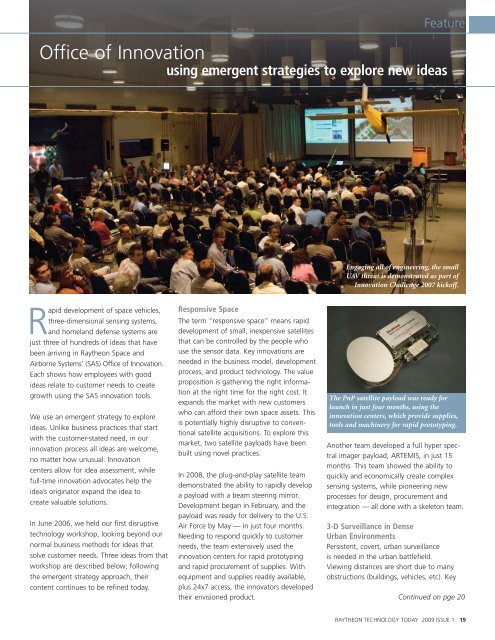2009 Issue 1 - Raytheon
2009 Issue 1 - Raytheon
2009 Issue 1 - Raytheon
Create successful ePaper yourself
Turn your PDF publications into a flip-book with our unique Google optimized e-Paper software.
Rapid development of space vehicles,<br />
three-dimensional sensing systems,<br />
and homeland defense systems are<br />
just three of hundreds of ideas that have<br />
been arriving in <strong>Raytheon</strong> Space and<br />
Airborne Systems’ (SAS) Office of Innovation.<br />
Each shows how employees with good<br />
ideas relate to customer needs to create<br />
growth using the SAS innovation tools.<br />
We use an emergent strategy to explore<br />
ideas. Unlike business practices that start<br />
with the customer-stated need, in our<br />
innovation process all ideas are welcome,<br />
no matter how unusual. Innovation<br />
centers allow for idea assessment, while<br />
full-time innovation advocates help the<br />
idea’s originator expand the idea to<br />
create valuable solutions.<br />
In June 2006, we held our first disruptive<br />
technology workshop, looking beyond our<br />
normal business methods for ideas that<br />
solve customer needs. Three ideas from that<br />
workshop are described below; following<br />
the emergent strategy approach, their<br />
content continues to be refined today.<br />
Responsive Space<br />
The term “responsive space” means rapid<br />
development of small, inexpensive satellites<br />
that can be controlled by the people who<br />
use the sensor data. Key innovations are<br />
needed in the business model, development<br />
process, and product technology. The value<br />
proposition is gathering the right information<br />
at the right time for the right cost. It<br />
expands the market with new customers<br />
who can afford their own space assets. This<br />
is potentially highly disruptive to conventional<br />
satellite acquisitions. To explore this<br />
market, two satellite payloads have been<br />
built using novel practices.<br />
In 2008, the plug-and-play satellite team<br />
demonstrated the ability to rapidly develop<br />
a payload with a beam steering mirror.<br />
Development began in February, and the<br />
payload was ready for delivery to the U.S.<br />
Air Force by May — in just four months.<br />
Needing to respond quickly to customer<br />
needs, the team extensively used the<br />
innovation centers for rapid prototyping<br />
and rapid procurement of supplies. With<br />
equipment and supplies readily available,<br />
plus 24x7 access, the innovators developed<br />
their envisioned product.<br />
Feature<br />
Office of Innovation<br />
using emergent strategies to explore new ideas<br />
Engaging all of engineering, the small<br />
UAV threat is demonstrated as part of<br />
Innovation Challenge 2007 kickoff.<br />
The PnP satellite payload was ready for<br />
launch in just four months, using the<br />
innovation centers, which provide supplies,<br />
tools and machinery for rapid prototyping.<br />
Another team developed a full hyper spectral<br />
imager payload, ARTEMIS, in just 15<br />
months. This team showed the ability to<br />
quickly and economically create complex<br />
sensing systems, while pioneering new<br />
processes for design, procurement and<br />
integration — all done with a skeleton team.<br />
3-D Surveillance in Dense<br />
Urban Environments<br />
Persistent, covert, urban surveillance<br />
is needed in the urban battlefield.<br />
Viewing distances are short due to many<br />
obstructions (buildings, vehicles, etc). Key<br />
Continued on pge 20<br />
RAYTHEON TECHNOLOGY TODAY <strong>2009</strong> ISSUE 1 19

















